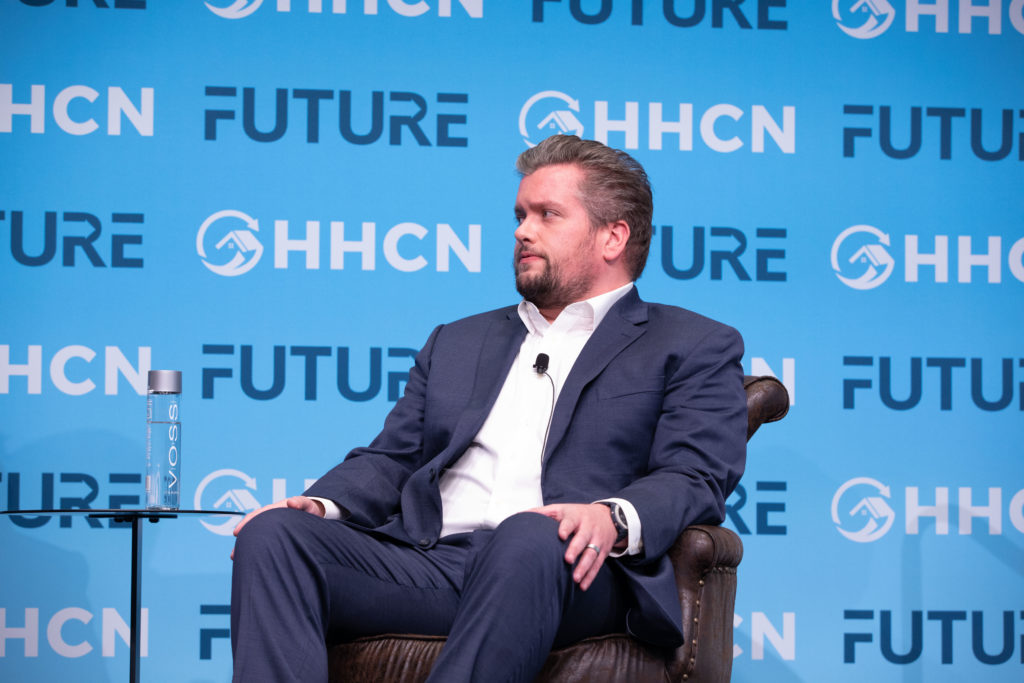
This article is a part of your HHCN+ Membership
Home health operators each year have to adapt on a number of different fronts, from relatively minor coding updates to major payment adjustments. But in addition to the more run-of-the-mill items, providers occasionally have to navigate macro-level forces that literally change the industry itself.
At least four such forces will redefine home health care in 2022, I believe.
Based on post-acute care dealmaking activity in the second half of 2021, it seems likely that next year will usher in the age of consolidation that everyone anticipated leading up to the Patient-Driven Groupings Model (PDGM), before the COVID-19 pandemic turned the world upside down. The consolidators won’t just be the usual suspects, however.
“I used to get four or five calls a month,” Stoneridge Partners President Rich Tinsley said at FUTURE. “Now, I get two to three a day, and it’s hard to keep up with them.”

Along with consolidation, the ongoing shift to value-based care will take center stage in the form of the Home Health Value-Based Purchasing (HHVBP) Model and Medicare Advantage (MA). Other, more innovative changes within fee-for-service Medicare, such as Choose Home, also have the potential to redefine the traditional home health model.
“I really haven’t yet met with a single congressional staffer or member of Congress since we’ve started where there’s been a response other than, ‘We like this idea conceptually. Now tell us more,’” Joanne Cunningham, executive director of the Partnership for Quality Home Healthcare (PQHH) told me in November in regard to Choose Home.
While consolidation, value-based care and care innovation present exciting opportunities for home health operators, labor forces and the public health emergency will continue to make their mark as well.
Post-acute care consolidation
Home health M&A activity rebounded in 2021, after PDGM and COVID-19 uncertainty combined to create somewhat of a drag in 2020. This momentum between buyers and sellers is set to continue heading into next year.
Despite some recent market turbulence, the key public players like Amedisys Inc. (Nasdaq: AMED), LHC Group Inc. (Nasdaq: LHCG) and Addus HomeCare Corporation (Nasdaq: ADUS) will assuredly remain active in the home health space. Some of the newer public players have been especially busy from a dealmaking perspective, too, and I anticipate them taking on an even greater role moving forward.
Atlanta-based Aveanna Healthcare Holdings Inc. (Nasdaq: AVAH) — a public company since early 2021 — is a prime example. Aveanna has acquired more than $290 million in revenue in 2021, far more than its usual target of between $150 million and $200 million.
The company most recently acquired Accredited Home Care, a private-duty services company based in Southern California, for a base purchase price of $180 million. Accredited isn’t exclusively a home health deal, but Aveanna has been very vocal about its intent to strategically expand in that area.
Shortly before landing Accredited, for instance, Aveanna also purchased the home health and hospice provider Comfort Care for $345 million.
“Each of the transactions [came in] highly competitive environments,” Aveanna Executive Chairman Rod Windley said during a third quarter earnings call. “We are fortunate to have them under contract. That deal flow has not slowed down in either segment. The strategic community along with private equity continues to make every transaction highly competitive.”
It’s not a hard-and-fast rule, but newly public companies often like to get off to fast starts. In 2022, that group may include BrightSpring Health Services, which filed the paperwork for a $100 million IPO in October, or whatever business that the special purpose acquisition company (SPAC) DTRT Health teams up with.

Outside of the public acquirers, regional home health players backed by PE have been noticeably more aggressive in 2021. That is all but guaranteed to continue in 2022, with private investors still sitting on an enormous amount of cash.
One related post-acute care storyline that I’m following: Consolidation is also happening in the skilled nursing facility (SNF) space, partially driven by PE dollars. That’s also primed to pick up in 2022.
“I’ve had more offers on deals than I ever have, over the past six months or so,” Matthew Alley, managing director at Senior Living Investment Brokerage, told Skilled Nursing News. “Capital has been sitting on the sidelines for a really long time, and they’re eager to get money invested.”
The shift to value
The U.S. Centers for Medicare & Medicaid Services (CMS) confirmed in November that it’s moving forward with the nationwide expansion of the HHVBP Model. The first performance year under the expanded initiative will be 2023, making 2022 a year for home health providers to focus more heavily on quality of care and internal processes.
For some, that will mean investing in stronger data and documentation tools. For others, it will mean devoting more resources to clinician education and training.
That’s exactly what the Kirkland, Washington-based EvergreenHealth Home Care did prior to the nine-state HHVBP demonstration beginning in 2016.
“Build an army of experts who are actually doing the work,” Brent Korte, the chief home care officer for EvergreenHealth, told me in August. “Have your clinicians be front and center. Make sure they know the answer to, ‘What is HHVBP’? Make sure they know, ‘How does my charting, how does my clinical care relate to the success of our agency?’”
I expect HHVBP to have a much larger impact once its upward or downward payment adjustments kick in a few years from now. But in 2022, its weight will start to be felt in how home health agencies carry themselves.
At the same time, increased MA penetration across the U.S. — and in the home health industry — will also make value-based care an important force in 2022. MA enrollment in 2022 is projected to reach 29.5 million people, up from 26.9 million in 2021, according to CMS.
“There’s a real opportunity for home health agencies because MA plans actually have more flexibility in terms of how they reimburse and utilize home health services,” Carter Bakkum, a senior data analyst at Trella Health, recently told HHCN.
Within the intersection of MA, value-based care and home health care, Humana Inc. (NYSE: HUM) may end up being a force in and of itself in 2022. Within the next five years, Humana wants to have 50% of its total MA population under its value-based home health model, CenterWell Home Health.
That makes next year a critical year for the Louisville, Kentucky-based insurer, which also happens to be the owner of the nation’s largest home health enterprise.
“Our efforts to transform home health to a value-based model come at a pivotal time for the industry,” Humana CEO Bruce Broussard said in November.
A new way of thinking
Care innovation, in the sense of rethinking the old home health model, will be a prevailing force next year.
Compared to a decade ago, home health patients are older and far more medically complex. Over one-quarter of patients, in fact, are over the age of 85 and about 43% have five or more chronic conditions, such as COPD, diabetes or heart disease, according to the latest Home Health Chartbook.
As if that didn’t make the job of home health providers challenging enough, over 37% of patients live alone, with over half having incomes at or under 200% of the federal poverty level.
Home health providers parachuting into a patient’s home after a hospital stay to deliver intermittent nursing or rehab services often isn’t enough anymore.
Choose Home embodies the degree of care innovation that’s needed to take home health care to the next level, I believe. Introduced in the Senate in July and the House in October, the legislation — championed by AARP, PQHH and the National Association for Home Care & Hospice (NAHC), among others — has a good chance of making it out of Washington, D.C., too.
Currently, supporters are monitoring opportunities to successfully pass Choose Home, whether that means attaching the bill to an end-of-year package or something else that comes along.
Broadly, Choose Home seeks to create an add-on to the traditional home health benefit to enable providers to care for more patients who would have otherwise been sent to a SNF to recover post-hospital discharge. The add-on would reimburse providers for services like telehealth support, transportation assistance and personal care services aimed at activities of daily living (ADLs).
“[Choose Home] would really allow us to add an additional benefit and have more appropriate patients going home versus, say, a short-term stay in a skilled nursing facility,” Chad Creech, chief integration and strategy officer at Alternate Solutions Health Network (ASHN), told me last month. “With the hospital partnerships, we are seeing higher-complexity cases, higher-acuity cases coming out of the hospital, even pre-COVID. And with COVID, when it hit, we started to see even more patients being sent home.”
What Amedisys is doing via its acquisition of Contessa Health is another good example of the kind of much needed home health care innovation that will become an even larger trend next year.
Familiar foes
Probably like most home health operators, I felt a lot better about 2022 a month ago than I do now, as of writing this on Dec. 2. I know we’re still waiting to learn a lot about the Omicron variant, including how contagious or severe it is compared to other variants, but this feels a lot like the days before the Delta surges.
On Wednesday, the first Omicron case was identified in California in an individual who traveled from South Africa on Nov. 22 before travel restrictions were put in place. To try to stay ahead of another surge, President Joe Biden on Thursday is expected to outline a new pandemic plan, which will include a focus on booster shots, new vaccination centers, tighter travel restrictions and insurance reimbursement for at-home COVID-19 testing.
If Omicron ends up being worse or just as bad as Delta, it could stretch home health providers even thinner in the new year. I’m particularly worried about what Omicron could mean from a staffing perspective.
Already, a shortage of in-home care clinicians has severely hampered providers’ ability to admit new patients. Many have turned to contract labor to reinforce their operations, but that’s an unsustainable resource at current rates.
“We’re living in an environment that has been disrupted by the pandemic,” Aveanna CEO Tony Strange said recently. “COVID-19, vaccinations and vaccination mandates have all played a role in disrupting business as we know it. The world in general — and health care, specifically — is being affected by what we refer to as a COVID-19 hangover. Magnify that with the political and social issues surrounding vaccinations, which are further complicated by a wide variety of mandates, and you will find yourself in a world where 3 million Americans have left the workforce.”
Unfortunately, the health care worker-vaccination issue just got more complicated this week, thanks to two main outcomes in federal court.
Companies featured in this article:
Alternate Solutions Health Network, Aveanna Healthcare, BrightSpring Health Services, EvergreenHealth Home Care, Partnership for Quality Home Healthcare, Stoneridge Partners






